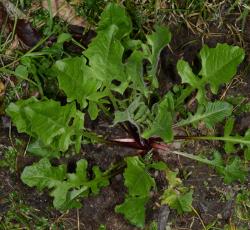- Taxon
- Gallery
Annual or biennial. Stems erect or ascending, branching, ribbed to grooved, 15–75–(100) cm tall; hairs both white, slender, crinkly, subappressed, and red-based, stout, straight, spreading. Rosette and lower stem lvs thick, petiolate, oblong to oblanceolate, usually deeply runcinately 1–2-pinnatifid, rarely simple and shallowly pinnatifid or toothed, (7)–10–20–(35) × (2)–4–8–(12) cm; hairs pale, 0.2–0.5 mm long, on both surfaces and margins; lobes slightly recurved, toothed or divided. Stem lvs similar, deeply pinnatisect to not lobed, toothed, sessile, subauriculate or lobed at base. Capitula campanulate; buds erect. Involucral bracts with pale subappressed cobwebby hairs and often dark, spreading glandular hairs on outer surface, and fine appressed straight hairs on inner surface; outer bracts 6–12, lanceolate to ovate-lanceolate, ?-1/2 length of inner bracts; inner bracts lanceolate, not keeled, (6)–9–12 mm long, with pale to scarious glabrous margins. Receptacle areoles with raised ciliate margins. Corolla yellow, sometimes with red stripe on outer face of ligule. Achenes brown, 10-ribbed, fusiform, scabrid, all long-beaked, 6–9 mm long. Pappus bristles in 1–(2) rows, fine, white.
[From: Webb et al. (1988) Flora of New Zealand. Volume 4.]
| Category | Number |
|---|---|
| Exotic: Fully Naturalised | 1 |
| Total | 1 |
Flowering: (Aug.)–Oct.–Dec.–(May); Fruiting: (Aug.)–Oct.–Dec.–(May)




